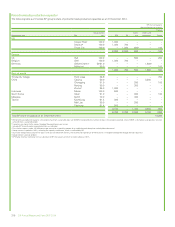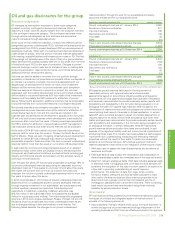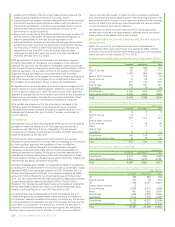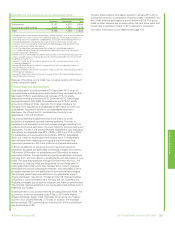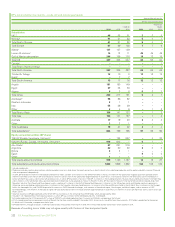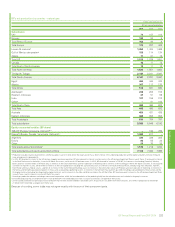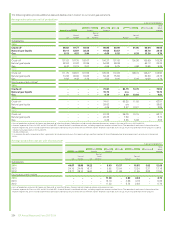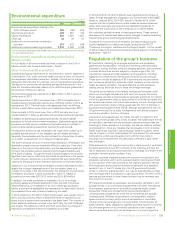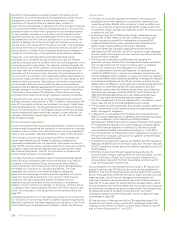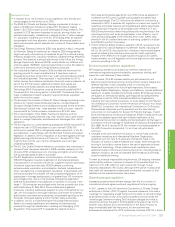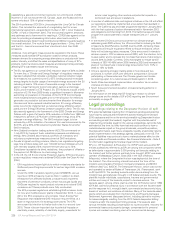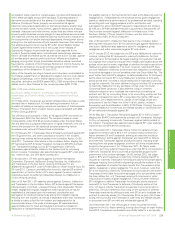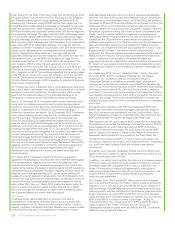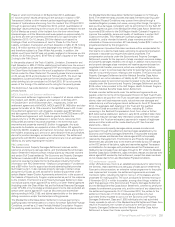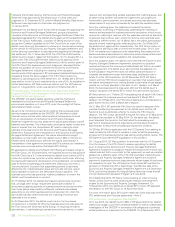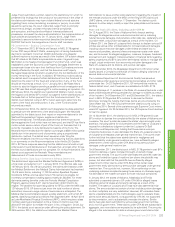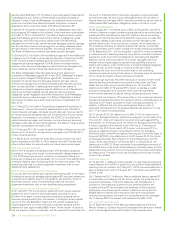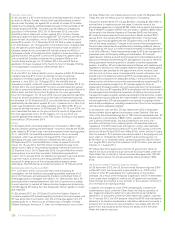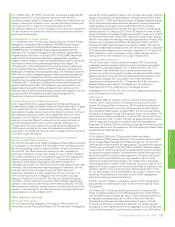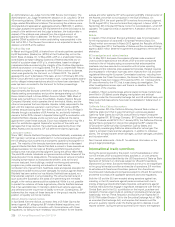BP 2014 Annual Report Download - page 232
Download and view the complete annual report
Please find page 232 of the 2014 BP annual report below. You can navigate through the pages in the report by either clicking on the pages listed below, or by using the keyword search tool below to find specific information within the annual report.
establishing a second commitment period to run until the end of 2020.
However, it will not include the US, Canada, Japan and Russia and thus
covers only about 15% of global emissions.
The 2014 conference (COP20) in Lima adopted the Lima Call for Climate
Action. This included the elements of a negotiating text for a new
international agreement, as specified in Durban in 2011, to be finalized at
COP21 in Paris in December 2015. This text covers long-term ambitions
and pathways and a framework for reaching it. COP20 also agreed on the
rules for providing and assessing information about each country’s
’Intended Nationally Determined Contributions (INDCs)’ towards reaching
the overall ambition. The world’s three largest emitters – China, the US
and the EU – have all announced their intentions to limit their GHG
emissions.
Additional, more stringent, measures can be expected in the future. These
measures could increase BP’s production costs for certain products,
increase demand for competing energy alternatives or products with lower-
carbon intensity, and affect the sales and specifications of many of BP’s
products. Current and announced measures and developments potentially
affecting BP’s businesses include the following:
• The EU has agreed to an overall GHG reduction target of 20% by 2020.
To meet this, a ‘Climate and Energy Package’ of regulatory measures
has been adopted that includes: a collective national reduction target
for emissions not covered by the EU ETS; binding national renewable
energy targets to double usage of renewable energy sources in the EU
including at least a 10% share of renewable energy in the transport
sector; a legal framework to promote carbon capture and storage
(CCS); and a revised EU ETS Phase 3. EU ETS revisions include a GHG
reduction of 21% from 2005 levels; a significant increase in allowance
auctioning; an expansion in the scope of the EU ETS to encompass
more industrial sectors and gases and no free allocation for electricity
generation or production but benchmarked free allocation for energy-
intensive and trade-exposed industrial sectors. EU energy efficiency
policy is currently implemented via national energy efficiency action
plans and the Energy Efficiency Directive adopted in 2012. The EU has
also recently agreed to the framework of the 2030 Climate and Energy
Policies with a goal of at least a 40% reduction in GHGs from 1990 and
measures to achieve a 27% share of renewable energy and a 27%
increase in energy efficiency. The GHG reduction target is to be
achieved by a 43% reduction of emissions from sectors covered by the
EU ETS, and a 30% GHG reduction by Member States for all other
GHG emissions.
• New Zealand’s emission trading scheme (NZ ETS) commenced on
1 July 2010 for transport fuels, industrial processes and stationary
energy. New Zealand also employs a portfolio of mandatory and
voluntary complementary measures aimed at GHG reductions.
• Canada’s highest emitting province, Alberta, has regulations targeting
large final emitters (sites with over 100,000 tonnes CO2e/per annum)
with intensity targets of 2% improvement per year up to 12%.
Compliance is possible via direct reductions, the purchase of offsets or
the payment of C$15/tonne to a technology fund.
• In the US, the US Environmental Protection Agency (EPA) continues to
pursue regulatory measures to address GHGs under the Clean Air Act
(CAA).
– EPA regulations impose light duty vehicle emissions standards for
GHGs and permitting requirements for certain large GHG emission
sources.
– Under the GHG mandatory reporting rule (GHGMRR), annual
reports on GHG emissions must be filed. In addition to direct
emissions from affected facilities, producers and importers/
exporters of petroleum products, certain natural gas liquids and
GHGs are required to report product volumes and notional GHG
emissions as if these products were fully combusted.
– The EPA proposed regulations establishing GHG emission limits
for new and modified power plants in September 2013. In June
2014, the EPA proposed a very complex ‘Clean Energy Plan’
Regulation that establishes GHG reduction requirements, at a
state or regional level, for existing power plants. The EPA
announced its intention to finalize both rules in or around June
2015. These rules are important due to potential impacts on
electricity prices, reliability of electricity supply, precedents for
similar rules targeting other sectors and potential impacts on
combined heat and power installations.
• A number of additional state and regional initiatives in the US will affect
our operations. California implemented a low-carbon fuel standard in
2010. The California cap and trade programme started in January 2012
with the first auctions of carbon allowances held in November 2012
and obligations commencing from 2013. The California cap and trade
programme was broadened to include transport fuels on 1 January
2015.
• In the recent US-China joint announcement on climate change
addressing post-2020 actions, the US committed to reducing its GHG
emissions by 26-28% below its 2005 level by 2025. Achieving these
reductions will require expanded efforts to reduce emissions, which
likely will include regulatory measures. China announced it intends to
achieve a peak in CO2 emissions around 2030, with the intention to try
to peak earlier and to increase the non-fossil fuel share of all energy to
around 20% by 2030. Currently, China has targets to reduce carbon
intensity of GDP 40-45% below 2005 levels by 2020 and increase the
share of non-fossil fuels in total energy consumption from 7.5% in
2005 to 15% by 2020.
• China is operating emission trading pilots in five cities and two
provinces. A number of BP joint venture*companies in China are
participating in these schemes. The Chinese government is also
considering a plan for a national cap and trade system in 2016.
• South Africa has delayed implementation of a carbon tax on carbon
intensive emitters until 2016.
• South Korea commenced its carbon emissions trading scheme in
January 2015.
For information on the steps that BP is taking in relation to climate
change issues and for details of BP’s GHG reporting see Environment
and society on page 42.
Legal proceedings
Proceedings relating to the Deepwater Horizon oil spill
BP’s potential liabilities resulting from threatened, pending and potential
future claims, lawsuits and enforcement actions relating to the 20 April
2010 explosions and fire on the semi-submersible rig Deepwater Horizon
and resulting oil spill (the Incident), together with the potential cost of
implementing remedies sought in the various proceedings, cannot be fully
estimated at this time, but they have had and could continue to have a
material adverse impact on the group’s business, competitive position,
financial performance, cash flows, prospects, liquidity, shareholder returns
and/or implementation of its strategic agenda, particularly in the US. The
potential liabilities may continue to have a material adverse effect on the
group’s results and financial condition. See Financial statements – Note 2
for information regarding the financial impact of the Incident.
BP p.l.c., BP Exploration & Production Inc. (BPXP) and various other BP
entities (collectively referred to as BP) are among the companies named
as defendants in approximately 3,000 pending civil lawsuits relating to
the Incident and further actions are likely to be brought. BPXP was lease
operator of Mississippi Canyon, Block 252 in the Gulf of Mexico
(Macondo), where the Deepwater Horizon was deployed at the time of
the Incident. The other working interest owners at the time of the
Incident were Anadarko Petroleum Company (Anadarko) and MOEX
Offshore 2007 LLC (MOEX). The Deepwater Horizon, which was owned
and operated by certain affiliates of Transocean Ltd. (Transocean), sank
on 22 April 2010. The pending lawsuits and/or claims arising from the
Incident have generally been brought in US federal and state courts. The
plaintiffs include individuals, corporations, insurers and governmental
entities and many of the lawsuits purport to be class actions. The
lawsuits assert, among others, claims under the Oil Pollution Act of 1990
(OPA 90), claims for personal injury in connection with the Incident itself
and the response to it, wrongful death, commercial and economic injury,
breach of contract and violations of statutes. Many of the lawsuits assert
claims which are excluded from the Economic and Property Damages
Settlement Agreement (discussed below), including claims for recovery
for losses allegedly resulting from the 2010 federal deepwater drilling
moratoria and/or the related permitting process. The lawsuits seek
various remedies including compensation to injured workers, recovery for
commercial losses and property damage, compensation for personal
injuries and medical monitoring, claims for environmental damage,
228 BP Annual Report and Form 20-F 2014


